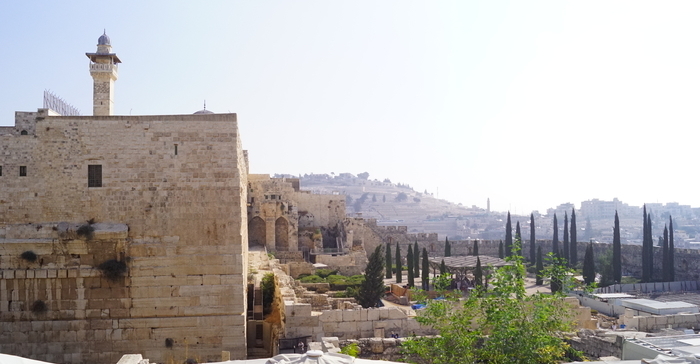BEGINNING EZEKIEL
by Roger Wyatt | 29th June 2021 | more posts on
'Getting to grips with the Prophets'| 1

Photograph: Roger Wyatt - the southern side of the Temple Mount looking towards the Mount of Olives
Getting to grips with Ezekiel 1-24
The book of Ezekiel, in many ways, stands apart from all the other books of the Nevi’im. Writing as a contemporary of Jeremiah, Ezekiel is among the last of the Babylonian Prophets and his prophetic output dates from the beginning of the 6th century BC to around 570. Ezekiel, although prophesying during the same period as Jeremiah, does not do so from Jerusalem, but from among the exiled communities of Judah that were forcibly relocated to Babylonia in 597. Taken as a whole Ezekiel brings a message, typical of the classical prophets, which is a mixture of proclamations concerning coming doom, but also of a far off hope. In addition to these, Ezekiel is also known for his majestic visions of an open heaven, encounters with angelic beings and his powerful, uncomfortable prophetic enactments.
The first twenty four chapters of Ezekiel are generally considered to be a distinct literary unit whilst chapters twenty-five to thirty-two consist of prophecies against the kingdoms caught up in the calamitous geo-political events at the beginning of the 6th century brought about by the rise of Nebuchadnezzar II. The remainder of the book, although commencing with the arrival of the terrible news that Jerusalem had fallen, takes on a more hopeful tone concerning the future restoration of God’s people to their land. The final eight chapters of the book represent one of the great puzzlements of the Hebrew canon, and in them the prophet receives a curious tour of the temple complex from a man with ‘a linen cord and a measuring rod in his hand’ (Ezekiel 40:3). Indeed, the centrality of the temple in the book is considerable and, despite the coming destruction of the sanctuary, it is the hope of restored worship and returned glory that are at the heart of Ezekiel’s vision.
Tackling the first twenty-four chapters of Ezekiel is a challenge, but it is one made easier once the underlying narrative structure of the prophetic writings is unearthed. Despite what appears to be an ordered number of chronological notes that begin many of the chapters, such as the historical superscription found in Ezekiel 1:1, a closer examination of the text soon reveals that the early chapters of Ezekiel are not arranged in a strictly chronological way. Moreover, it is impossible to locate exactly when some of the prophecies took place, albeit it can with some assurance be concluded that the body of prophecies found between chapters 1 and 23 were given prior to arrival of Nebuchadnezzar at the walls of Jerusalem on 10th Tebet 589:
‘In the ninth year, in the tenth month on the tenth day, the word of the LORD came to me: “Son of man, record this date, this very date, because the king of Babylon has laid siege to Jerusalem this very day.”’ (Ezekiel 24:1-2)
Taken at face value the inaugural visions of Ezekiel, found in chapters 1 to 3, are followed immediately by God’s command to Ezekiel to enact the siege of Jerusalem whilst lying on his side for a total of four hundred and thirty days. However, it seems likely that chapters 4 to 7 have been placed out of chronological order - they concern the imminent arrival of Nebuchadnezzar to besiege the city, an event still four years in the future. In contrast, the prophecies found in Ezekiel 8 to 11 chronologically, and indeed semantically, follow on from those of chapters 1-3 and can be dated to just over one year after the inaugural visions: ‘In the sixth year, in the sixth month on the fifth day, while I was sitting in my house and the elders of Judah were sitting before me, the hand of the Sovereign LORD came on me there’ (Ezekiel 8:1) – that is, the 6th Elul 592. Not only do these chapters describe the departure of the glory of God from the temple in Jerusalem, but they also begin a period of around three and a half years of judgment against the city that would be a precursor to the arrival of Nebuchadnezzar.
The prophecies found in chapters 20-23 are clearly marked as belonging to the year following those of chapters 8 to 11: ‘In the seventh year, in the fifth month on the tenth day, some of the elders of Israel came to inquire of the LORD, and they sat down in front of me’, that is the 10th Ab 591. Ezekiel has already been ‘present’ in Jerusalem in chapters 8 to 11, and here the text reads as if the prophet has been supernaturally and temporarily returned to the land of Israel – his prophecies centre of the rebellion and coming punishment of Judah.
In chapter 12 Ezekiel is asked to enact the failed escape of Zedekiah from Jerusalem, and the sense of the imminent arrival of Nebuchadnezzar builds: ‘But I the LORD will speak what I will, and it shall be fulfilled without delay’ (12:25). The prophecies of chapters 12 to 19 then, may belong to the period of political unrest prior to Nebuchadnezzar’s arrival c.590. Indeed, chapters 4 to 7 share the same message: ‘The end is now upon you, and I will unleash my anger against you’ (Ezekiel 7:3) and may properly belong, chronologically at least, to a moment prior to chapter 24; in verse sixteen of chapter 4, Yahweh declares to Ezekiel: ‘“Son of man, I am about to cut off the food supply in Jerusalem”’. As such, it would not be surprising if Ezekiel carried out his strange mandate at a time concurrent with the actual siege (from the end of 589 to 586).
And so, Ezekiel 1-24 when arranged within the wider almost undetectable narrative recounts the prophetic ministry of the prophet from his call, the arrival of Nebuchadnezzar at the walls of the Jerusalem, and the siege enactment. In the year following his 593 inaugural visions and divine commissioning while at the Kebar river, Ezekiel is transported to Jerusalem where he witnesses the departure of God’s glory from the city and the commencement of divine judgement against those engaged in idolatry. In 591, he is again, it seems, supernaturally present in Jerusalem and prophesying against those who have come to enquire of the LORD. After this, in the year before the siege of the Jerusalem, Ezekiel prophetically addresses his own exiled community, acting out the coming exile of king Zedekiah. Finally, in the months prior to Nebuchadnezzar’s arrival, Ezekiel is prepared for his lengthy prophetic enactment of besieging Jerusalem, which commences I suggest, as the Babylonian king sets up his siege ramps.
A suggested reading of the first twenty-four chapters of Ezekiel
Ezekiel 1-3 (593)
Ezekiel 8-11 (592)
Ezekiel 20-23 (591)
Ezekiel 12-19 (c. 590)
Ezekiel 4-7 (c.589)
Ezekiel 24 (589)
